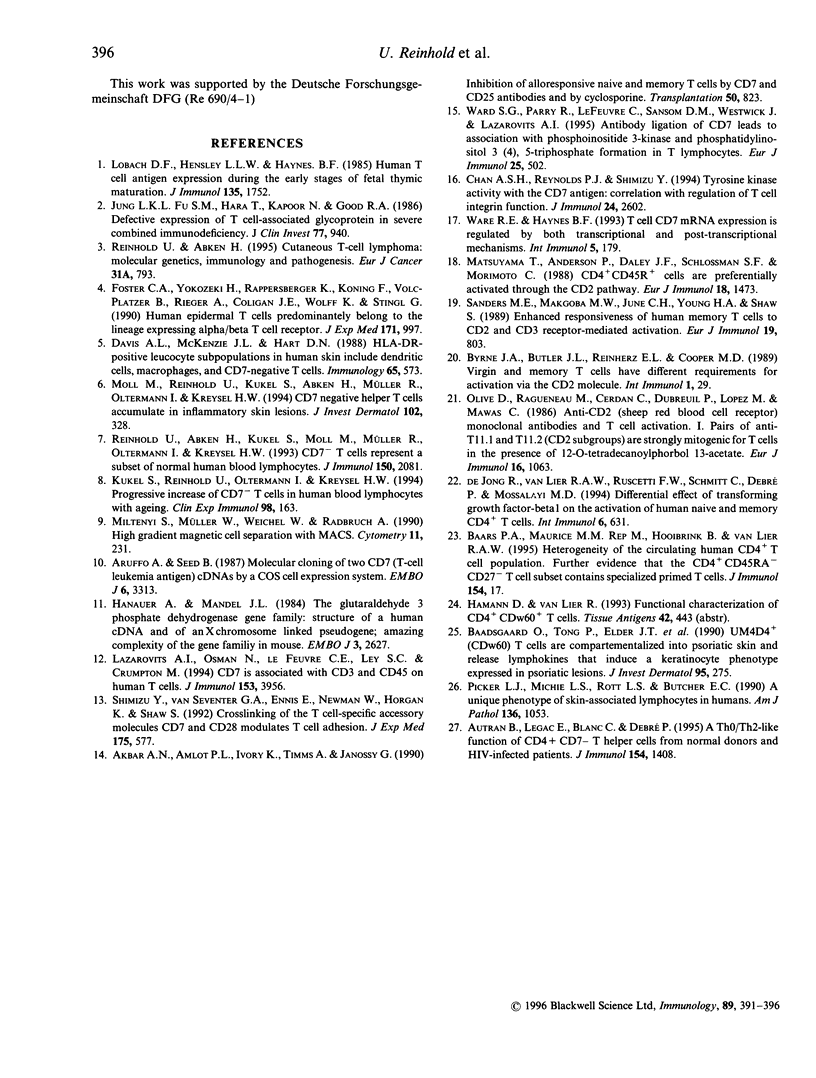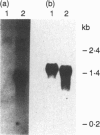Abstract
The absence of CD7 protein and the corresponding mRNA is a stable feature in a subset of normal circulating CD4+ memory T cells. It is still unresolved whether the CD7- subset represents a specific T-cell lineage. Here we show that repeated stimulation of highly purified CD4+ CD45RA+ CD45RO- naive T cells in vitro leads to the development of a distinct memory subset that is defined by the expression versus non-expression of the CD7 antigen. Comparing different T-cell activation pathways (TCR/CD3, CD2), we observed that alternative signals were critically involved in the development of CD4+ CD7- T cells. Peak mean numbers of CD7- memory cells occurred after 3-5 cycles of restimulation in vitro. Naive T cells that had undergone repeated stimulations were harvested and sorted into CD7+ and CD7- subsets. The vast majority (> 97%) of CD7+ T cells retained their expression, whereas the CD7- population did not re-express the antigen during further propagation of separated T-cell subsets. In CD7- cells no CD7 mRNA was monitored, indicating transcriptional regulation of CD7 expression. Certain differentiation-related antigens, including the cutaneous lymphocyte antigen CLA, were preferentially expressed on CD7- T cells. We suggest that absence of CD7 expression in a subset of CD4+ memory cells reflects a separate and stable differentiation state occurring late in the immune response. These T cells may represent the physiological counterpart of malignant T cells in certain forms of cutaneous T-cell lymphoma.
Full text
PDF





Images in this article
Selected References
These references are in PubMed. This may not be the complete list of references from this article.
- Akbar A. N., Amlot P. L., Ivory K., Timms A., Janossy G. Inhibition of alloresponsive naive and memory T cells by CD7 and CD25 antibodies and by cyclosporine. Transplantation. 1990 Nov;50(5):823–829. doi: 10.1097/00007890-199011000-00016. [DOI] [PubMed] [Google Scholar]
- Aruffo A., Seed B. Molecular cloning of two CD7 (T-cell leukemia antigen) cDNAs by a COS cell expression system. EMBO J. 1987 Nov;6(11):3313–3316. doi: 10.1002/j.1460-2075.1987.tb02651.x. [DOI] [PMC free article] [PubMed] [Google Scholar]
- Autran B., Legac E., Blanc C., Debré P. A Th0/Th2-like function of CD4+CD7- T helper cells from normal donors and HIV-infected patients. J Immunol. 1995 Feb 1;154(3):1408–1417. [PubMed] [Google Scholar]
- Baadsgaard O., Tong P., Elder J. T., Hansen E. R., Ho V., Hammerberg C., Lange-Vejlsgaard G., Fox D. A., Fisher G., Chan L. S. UM4D4+ (CDw60) T cells are compartmentalized into psoriatic skin and release lymphokines that induce a keratinocyte phenotype expressed in psoriatic lesions. J Invest Dermatol. 1990 Sep;95(3):275–282. doi: 10.1111/1523-1747.ep12484908. [DOI] [PubMed] [Google Scholar]
- Byrne J. A., Butler J. L., Reinherz E. L., Cooper M. D. Virgin and memory T cells have different requirements for activation via the CD2 molecule. Int Immunol. 1989;1(1):29–35. doi: 10.1093/intimm/1.1.29. [DOI] [PubMed] [Google Scholar]
- Chan A. S., Reynolds P. J., Shimizu Y. Tyrosine kinase activity associated with the CD7 antigen: correlation with regulation of T cell integrin function. Eur J Immunol. 1994 Nov;24(11):2602–2608. doi: 10.1002/eji.1830241106. [DOI] [PubMed] [Google Scholar]
- Davis A. L., McKenzie J. L., Hart D. N. HLA-DR-positive leucocyte subpopulations in human skin include dendritic cells, macrophages, and CD7-negative T cells. Immunology. 1988 Dec;65(4):573–581. [PMC free article] [PubMed] [Google Scholar]
- Foster C. A., Yokozeki H., Rappersberger K., Koning F., Volc-Platzer B., Rieger A., Coligan J. E., Wolff K., Stingl G. Human epidermal T cells predominantly belong to the lineage expressing alpha/beta T cell receptor. J Exp Med. 1990 Apr 1;171(4):997–1013. doi: 10.1084/jem.171.4.997. [DOI] [PMC free article] [PubMed] [Google Scholar]
- Hanauer A., Mandel J. L. The glyceraldehyde 3 phosphate dehydrogenase gene family: structure of a human cDNA and of an X chromosome linked pseudogene; amazing complexity of the gene family in mouse. EMBO J. 1984 Nov;3(11):2627–2633. doi: 10.1002/j.1460-2075.1984.tb02185.x. [DOI] [PMC free article] [PubMed] [Google Scholar]
- Jung L. K., Fu S. M., Hara T., Kapoor N., Good R. A. Defective expression of T cell-associated glycoprotein in severe combined immunodeficiency. J Clin Invest. 1986 Mar;77(3):940–946. doi: 10.1172/JCI112393. [DOI] [PMC free article] [PubMed] [Google Scholar]
- Kukel S., Reinhold U., Oltermann I., Kreysel H. W. Progressive increase of CD7- T cells in human blood lymphocytes with ageing. Clin Exp Immunol. 1994 Oct;98(1):163–168. doi: 10.1111/j.1365-2249.1994.tb06624.x. [DOI] [PMC free article] [PubMed] [Google Scholar]
- Lazarovits A. I., Osman N., Le Feuvre C. E., Ley S. C., Crumpton M. J. CD7 is associated with CD3 and CD45 on human T cells. J Immunol. 1994 Nov 1;153(9):3956–3966. [PubMed] [Google Scholar]
- Lobach D. F., Hensley L. L., Ho W., Haynes B. F. Human T cell antigen expression during the early stages of fetal thymic maturation. J Immunol. 1985 Sep;135(3):1752–1759. [PubMed] [Google Scholar]
- Matsuyama T., Anderson P., Daley J. F., Schlossman S., Morimoto C. CD4+CD45R+ cells are preferentially activated through the CD2 pathway. Eur J Immunol. 1988 Sep;18(9):1473–1476. doi: 10.1002/eji.1830180926. [DOI] [PubMed] [Google Scholar]
- Miltenyi S., Müller W., Weichel W., Radbruch A. High gradient magnetic cell separation with MACS. Cytometry. 1990;11(2):231–238. doi: 10.1002/cyto.990110203. [DOI] [PubMed] [Google Scholar]
- Moll M., Reinhold U., Kukel S., Abken H., Müller R., Oltermann I., Kreysel H. W. CD7-negative helper T cells accumulate in inflammatory skin lesions. J Invest Dermatol. 1994 Mar;102(3):328–332. doi: 10.1111/1523-1747.ep12371791. [DOI] [PubMed] [Google Scholar]
- Olive D., Ragueneau M., Cerdan C., Dubreuil P., Lopez M., Mawas C. Anti-CD2 (sheep red blood cell receptor) monoclonal antibodies and T cell activation. I. Pairs of anti-T11.1 and T11.2 (CD2 subgroups) are strongly mitogenic for T cells in presence of 12-O-tetradecanoylphorbol 13-acetate. Eur J Immunol. 1986 Sep;16(9):1063–1068. doi: 10.1002/eji.1830160906. [DOI] [PubMed] [Google Scholar]
- Picker L. J., Michie S. A., Rott L. S., Butcher E. C. A unique phenotype of skin-associated lymphocytes in humans. Preferential expression of the HECA-452 epitope by benign and malignant T cells at cutaneous sites. Am J Pathol. 1990 May;136(5):1053–1068. [PMC free article] [PubMed] [Google Scholar]
- Reinhold U., Abken H. Cutaneous T-cell lymphoma: molecular genetics, immunology and pathogenesis. Eur J Cancer. 1995;31A(5):793–799. doi: 10.1016/0959-8049(95)00089-2. [DOI] [PubMed] [Google Scholar]
- Sanders M. E., Makgoba M. W., June C. H., Young H. A., Shaw S. Enhanced responsiveness of human memory T cells to CD2 and CD3 receptor-mediated activation. Eur J Immunol. 1989 May;19(5):803–808. doi: 10.1002/eji.1830190504. [DOI] [PubMed] [Google Scholar]
- Shimizu Y., van Seventer G. A., Ennis E., Newman W., Horgan K. J., Shaw S. Crosslinking of the T cell-specific accessory molecules CD7 and CD28 modulates T cell adhesion. J Exp Med. 1992 Feb 1;175(2):577–582. doi: 10.1084/jem.175.2.577. [DOI] [PMC free article] [PubMed] [Google Scholar]
- Ward S. G., Parry R., LeFeuvre C., Sansom D. M., Westwick J., Lazarovits A. I. Antibody ligation of CD7 leads to association with phosphoinositide 3-kinase and phosphatidylinositol 3,4,5-trisphosphate formation in T lymphocytes. Eur J Immunol. 1995 Feb;25(2):502–507. doi: 10.1002/eji.1830250229. [DOI] [PubMed] [Google Scholar]
- Ware R. E., Haynes B. F. T cell CD7 mRNA expression is regulated by both transcriptional and post-transcriptional mechanisms. Int Immunol. 1993 Feb;5(2):179–187. doi: 10.1093/intimm/5.2.179. [DOI] [PubMed] [Google Scholar]
- de Jong R., van Lier R. A., Ruscetti F. W., Schmitt C., Debré P., Mossalayi M. D. Differential effect of transforming growth factor-beta 1 on the activation of human naive and memory CD4+ T lymphocytes. Int Immunol. 1994 Apr;6(4):631–638. doi: 10.1093/intimm/6.4.631. [DOI] [PubMed] [Google Scholar]



